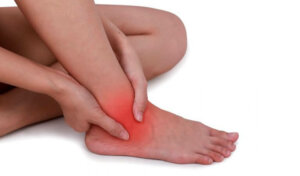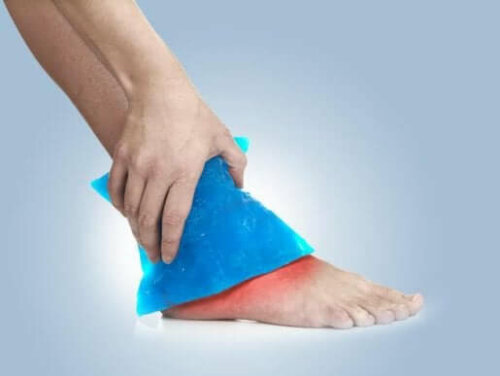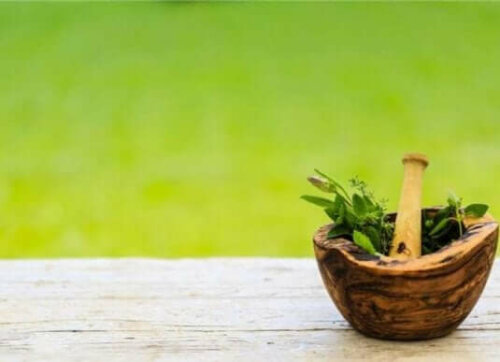Natural Remedies to Relieve a Sprained Ankle

To relieve a sprained ankle you need to follow a series of steps that we all know about. Use crutches, bandages, or apply a cast to the foot. However, there are times when complementary natural remedies can relieve pain and speed up the recovery process.
A sprained ankle is common in both athletes and the general population. It occurs because the ligaments are forced causing a tear. If not detected early, the sprain may cause disability. Therefore, it’s important to see a doctor as soon as possible.
Complementary remedies for treating a sprained ankle
The complementary remedies to treat a sprained ankle will allow us to relieve the pain, the discomfort and speed up the recovery. However, we must follow the doctor’s instructions. In no case are these remedies a substitute for a doctor’s recommendations.
Apply ice to the affected area

This first option for relieving a sprained ankle is known as cryotherapy. It’s usually used therapeutically in some cases by contrast baths, by cryomassages, or by using cold pillows with circulating water.
Ice is an excellent natural option to relieve a sprained ankle. When applied to the area, blood vessels contract and cooling stimulates the release of a very important hormone, called serotonin. In this way, the pain is relieved and we feel much better.
We should never apply the ice directly on the ankle because it will burn and can cause additional pain. Therefore, it’s best to use ice packs. However, there are other alternatives such as putting your ankle under a very cold water stream.
Perhaps you’ll find this interesting: Heal a Sprained Ankle with Complementary Remedies
Arnica compress
Arnica is a plant used in natural medicine to relieve bruises, bruises, muscle aches, and sprains. We can find it in a gel form to apply with a gentle massage, or in an oil or herbal format.
Using this plant for a sprained ankle will allow us to feel its pain relief effect. At the same time, the inflammation will be reduced by the massage that we’ll give in the area with the oil or gel. Arnica, in its herbal format, can be used in a compress.
- Boil some arnica leaves. Then, crush them into a paste with a pestle and mortar. This shouldn’t be too watery.
- Prepare an arnica tea and soak a compress in it. Apply the compression over the ankle immediately. Its warmth will provide a soothing effect.
For more information: Arnica and coconut oil ointment to relieve lower back pain
Using the Symphytum officinale plant

The Symphytum officinale plant is part of traditional medicine to relieve the symptoms of sprains and dislocations. However, we can now produce a poultice. Also, apply a hot water compress immersed in a tea of this remedy to relieve ankle pain.
However, it’s important, with this remedy and the first, that, during the first three days, you only use ice. The reason is that if you only apply heat, the blood vessels will dilate causing more inflammation.
Another aspect that we need to consider is that we must compress the ankle with bandages and raise the foot. These will also help reduce inflammation. Also, if we apply ice and then use the two remedies mentioned, the treatment will be entirely successful.
A sprained ankle will force us to rest so that it can heal well and prevent future problems. We encourage you to try these options if you need to relieve a sprained ankle. In this way, you won’t have to keep your leg up for so long, and you can control pain and inflammation.
All cited sources were thoroughly reviewed by our team to ensure their quality, reliability, currency, and validity. The bibliography of this article was considered reliable and of academic or scientific accuracy.
- del Puerto Horta, Myrna, Casas Insua, Leivis, & Cañete Villafranca, Roberto. (2013). Usos más frecuentes de Arnica montana. Revista Cubana de Plantas Medicinales, 18(2), 315-326. Recuperado en 09 de febrero de 2019, de http://scielo.sld.cu/scielo.php?script=sci_arttext&pid=S1028-47962013000200014&lng=es&tlng=es.
- Madrid de Zito Fontan, L. (2011). Farmacopea Herbolaria y terapia ritual: Una contribución para el estudio de la medicina tradicional de la yunga boliviana. Scripta Ethnologica, 33.
-
“PLENARIAS”. Vitae, vol. 18, no. 2, 2011, pp. s18-s334. Editorial Universidad de Antioquia.
- Sanz Pozo, B., Moreno García, A., & Rubio Toledano, L.. (2001). Rotura del tendón de Aquiles: a propósito de un esguince de mala evolución. Medifam, 11(7), 55-60. Recuperado en 09 de febrero de 2019, de http://scielo.isciii.es/scielo.php?script=sci_arttext&pid=S1131-57682001000700006&lng=es&tlng=es.
- Waizel-Bucay, José, & Cruz-Juárez, María de Lourdes. (2014). Arnica montana L., planta medicinal europea con relevancia. Revista mexicana de ciencias forestales, 5(25), 98-109. Recuperado en 09 de febrero de 2019, de http://www.scielo.org.mx/scielo.php?script=sci_arttext&pid=S2007-11322014000500008&lng=es&tlng=es.
- Waizel-Bucay, J., Waizel-Haiat, S., & Revilla-Peñaloza, F. (2017, September). Los productos herbolarios, la coagulación sanguínea y la cirugía otorrinolaringológica. In Anales de Otorrinolaringología (Vol. 62, No. 2, pp. 115-142).
This text is provided for informational purposes only and does not replace consultation with a professional. If in doubt, consult your specialist.








